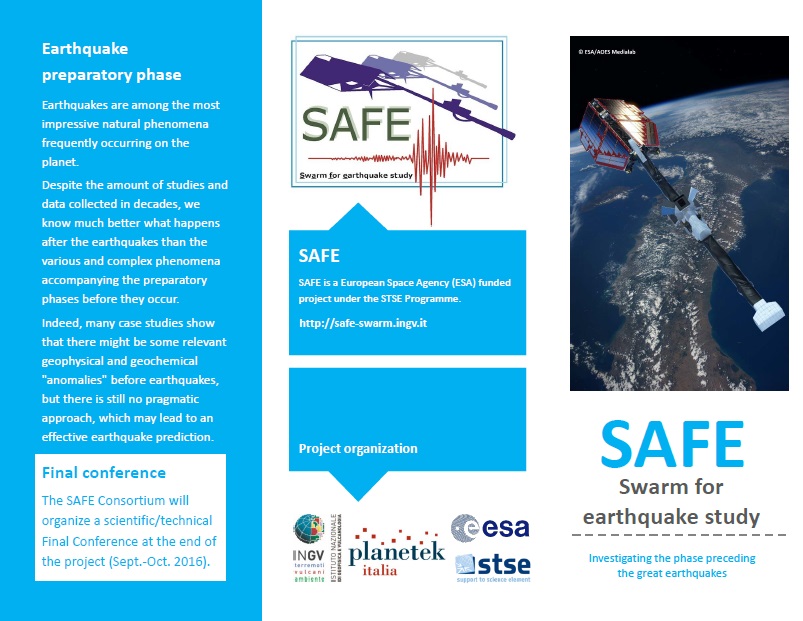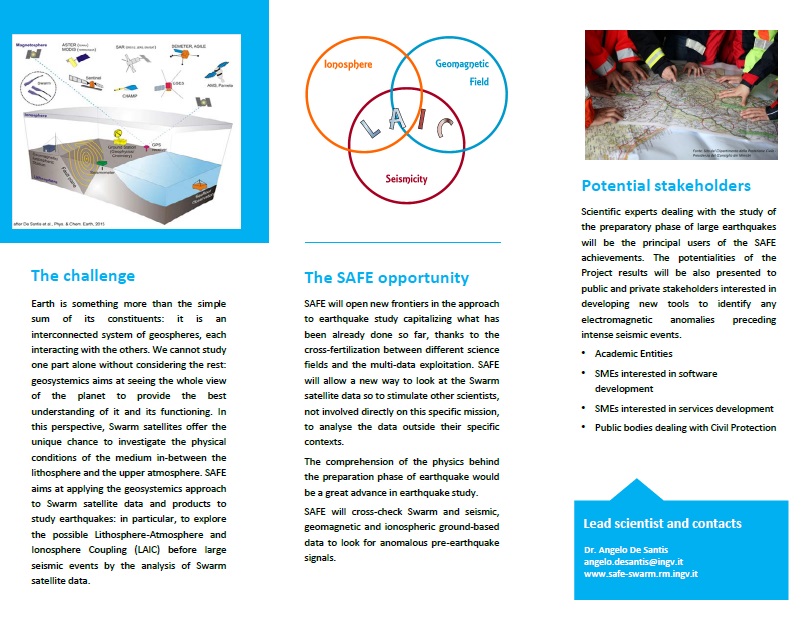The project called "Swarm for earthquake study (SAFE)" will study, based on data collected from satellites and from ground-based instruments, what happens during the phase preceding the great earthquakes, trying to identify any electromagnetic signals from space. The project is coordinated by the INGV and funded by the European Space Agency. Planetek Italia will also collaborate to the project.
SAFE is going to start on May 2, 2015, and will last 16 months.
"The project aims to study the preparatory phase of large earthquakes through the analysis of electromagnetic data from sensors onboard the three satellites of ESA Swarm constellation in order to better understand the physical mechanisms involved," says Angelo De Santis, research director of the INGV and coordinator of the study - In particular, the Safe project aims to study the coupling between the outer part of the solid Earth, the lithosphere, where the earthquakes occur, and the overlying fluid portion, the atmosphere, with the objective to capture the information exchanged between the two layers through the integration of the data acquired by the satellites Swarm with those collected by other satellites and measuredby ground-based stations"
* Studiare i terremoti dalla Terra e dallo Spazio (INGV) | Ingv studia i terremoti dalla terra e dallo spazio (Protezione Civile)
Lithosphere-Atmosphere-Ionosphere Coupling before Large Earthquakes (A. De Santis)

* Geospace perturbations induced by the Earth: The state of the art and future trends (Physics and Chemistry of the Earth)
A. De Santis, G. De Franceschi, R. Di Giovambattista, L. Perrone, L. Alfonsi, G. Cianchini, F. J. Pavon-Carrasco, C. Cesaroni, L. Spogli
De Santis A., Alfonsi L., Cesaroni C., Cianchini G., De Franceschi G., Di Giovambattista R., Pavon Carrasco F.-J., Perrone L., Spogli L., Abbattista C., Amoruso L., Carbone M., Drimaco D.
The primary goal of the Swarm satellite mission is to measure the Earth's magnetic field. The newborn SAFE project (funded by ESA under the framework STSE Swarm+Innovation, 2014) aims at applying the new approach of geosystemics to the analysis of Swarm data for investigating the preparatory phase of earthquakes. The main objective is to explore the possible link between magnetic/ionospheric anomalies and large earthquakes analysing Swarm as well as ground-based data (seismic, magnetic, GNSS, etc.). This paper shows the state of the art in lithosphere-atmosphere-ionosphere coupling (LAIC) and the expected contribution of SAFE in the field.
* Long-term continuous radon monitoring in Italy [DOI: 10.4401/ag-6735] | Real-time radon monitoring in the laboratory: a pilot approach to investigate the Earth crust
Comparisons of SWARM Electron Temperature Data with IRI
Vladimir Truhlik, Dieter Bilitza, Claudia Stolle, Stephan Buchert, Ales Bezdek, Katerina Podolska, Ludmila Triskova
SAFE ESA-funded Project: space weather fundamental for pre-earthquake signals confutation De santis, A et al.
The SAFE ESA-funded Project: how to approach for an integrated system of earthquake physics study
* Swarm Two Years on: Achievements in Unraveling the Earth's Magnetic Field I | II Posters
Although magnetometers may be capable of picking up precursor signals in surface rocks, they have one major drawback: They must be located within 100 kilometers or so of the epicenter. That’s why Angelo de Santis, director of research at the National Institute of Geophysics and Volcanology in Rome, and others have turned to satellites to get a global view of what happens in the atmosphere before earthquakes. Through a new research initiative called SAFE (Swarm for earthquake study), de Santis and his colleagues will pair data from the European Space Agency’s Swarm satellites, launched in 2013, with those from traditional earthquake monitoring devices like seismometers and GPS stations.
Their goal, de Santis says, is first to understand the link between Earth’s crust and atmosphere. “If you understand the physics, you double the chances to make predictions,” he says. They will also study past earthquakes to identify any patterns that precede known ruptures, and then see whether those same patterns precede future earthquakes. Already, at the meeting, they reported finding ionospheric anomalies before the 2014 Iquique earthquake in Chile and the recent disaster in Nepal.
* 電磁気変化に着目した地震予知理論、日本人科学者が発表 (Chosun Online)
Satellite measurements such as those provided by the present ESA Swarm mission provide measurements of the geomagnetic field with unprecedented spatial resolution and homogeneous coverage, which are not available from Earth’s surface data. On the other hand, downward continuation of satellite data is affected by external magnetic field sources in the ionosphere. Within this context, land, ocean and near surface measurements are an essential complement of satellite data.
Swarm satellite data analysis for some earthquake case studies
De Santis, Angelo (1); De Franceschi, Giorgiana (1); Di Giovambattista, Rita (1); Perrone, Loredana (1); Alfonsi, Lucilla (1); Cianchini, Gianfranco (1); Pavon-Carrasco, Francisco Javier (1); Cesaroni, Claudio (1); Spogli, Luca (1); Malagnini, Andrea (1); Settimi, Alessandro (1); Piscini, Alessandro (1); De Santis, Anna (1); Amoruso, Leonardo (2); Carbone, Marianna (2) 1: INGV, Rome, Italy; 2: Planetek Italia, Bari, Italy
Earthquakes Boards
To pursue the SAFE Project objectives and in order to investigate ionospheric signatures of possible lithospheric origin, the geospace conditions have been carefully investigated by considering the following worldwide adopted geomagnetic indices: ap, AE and Dst. When these indices exceeded a given threshold, the anomalies detected from both ground based and in situ data are described as external forcing related, without fully excluding their possible LAIC origin. The results shown on the following data-sheets are then based on the above considerations.
Cubesat projects within IPGP
Lixin Wu, Shuo Zheng, Angelo De Santis, Kai Qin, Rosa Di Mauro, Shanjun Liu, and Mario Luigi Rainone
Conveners: Angelo De Santis, Vladimir Kossobokov, Dimitar Ouzounov, Gerassimos Papadopoulos, Antonella Peresan, Sergey Pulinets, J.D. Zechar
A new study by Xiong et al. connects these losses of GPS signal to equatorial plasma irregularities (EPIs), which occur when the electron density in the ionosphere’s F region undergoes large, rapid changes. EPIs mostly occur close to Earth’s magnetic equator, which might explain why the loss of GPS signal to Swarm satellites also occurred most frequently when the satellites were at low latitudes.
* The Swarm satellite loss of GPS signal and its relation to ionospheric plasma irregularities (Space Weather)
Alexander Grayver, from ETH Zurich, said, “The Swarm and Champ satellites have allowed us to distinguish between the rigid ocean ‘lithosphere’ and the more pliable ‘asthenosphere’ underneath.”
The lithosphere is the rigid outer part of the earth, consisting of the crust and upper mantle, while the asthenosphere lies just below the lithosphere and is hotter and more fluid than the lithosphere.
“Effectively, ‘geo-electric sounding from space’, this result is a first for space exploration,” he continues.
“These new results are important for understanding plate tectonics, the theory of which argues that Earth’s lithosphere consists of rigid plates that glide on the hotter and less rigid asthenosphere that serves as a lubricant, enabling plate motion.”* Satellite tidal magnetic signals constrain oceanic lithosphere-asthenosphere boundary (Science Advances)
Attendance is free of charge, but registration is required from 16 August to 30 September 2016.
The preliminary agenda is available here
A. De Santis G. Balasis F.J. Pavón-Carrasco G. Cianchini M. Mandea
A systemic approach to the study of the preparatory phase of a strong earthquake. The magnetic anomalies and collected by the ionospheric Swarm satellites could in the future to anticipate the arrival of the strongest earthquakes. ESA support to SAFE project recently concluded
Swarm satellite data analysis for earthquake preparatory phase study Angelo De Santis on the behalf of SAFE Team
The Contribution of CSES Mission to Study Lithosphere-Atmosphere-Ionosphere Coupling Phenomena Through the Analysis of Combined Missions Data and Ground Measurements Livio Conti
CSES Electric Field Detector Calibration Tools Based on IRI, IGRF, and SWARM Data Piero Diego
P06: Remote sensing of earthquakes, lightning and radiation belts - posters
Time: Monday, 20/Mar/2017: 6:00pm - 7:00pm
Chair: Michael E Purucker
Chair: Georgios Balasis3AM1: Remote sensing of earthquakes, lightning and radiation belts
Time: Wednesday, 22/Mar/2017: 8:30am - 10:05am
Session Chair: Michael E Purucker
Session Chair: Georgios Balasis
* Supersonic plasma jets discovered | 地球上空を取り巻く超音速のプラズマジェットの存在を欧州宇宙機関が観測に成功 | 地壳所提前部署电磁监测试验卫星在轨交叉检验计划
An integrated approach to pre-earthquake physics study: some results from the SAFE Project, Angelo De Santis and the SAFE Project
A new multi-parametric climatological approach to the study of the earthquake preparatory phase: the 2016 Amatrice-Norcia (Central Italy) seismic sequence Alessandro Piscini, Angelo De Santis, Dedalo Marchetti, and Gianfranco Cianchini
Xuhui Shen Status of China Earthquake-related Satellite Missions (CSES) mission and data policy
Robert H. Tyler, Tim P. Boyer, Takuto Minami, Melissa M. Zweng and James R. Reagan
Mehdi Akhoondzadeh, Angelo De Santis, Dedalo Marchetti, Alessandro Piscini, Gianfranco Cianchini
With the aim of making the best possible use of existing satellites, ESA and Canada have made a deal that turns Swarm into a four-satellite mission to shed even more light on space weather and features such as the aurora borealis.
In orbit since 2013, ESA’s three identical Swarm satellites have been returning a wealth of information about how our magnetic field is generated and how it protects us from dangerous electrically charged atomic particles in the solar wind.
Canada’s Cassiope satellite carries three instrument packages, one of which is e-POP. It delivers information on space weather which complements that provided by Swarm. Therefore, the mission teams began looking into how they could work together to make the most of the two missions.
Dragos Armand Stanica, Dumitru Stanica, Jan Błęcki, Tomasz Ernst, Waldemar Jóźwiak, Jan Słomiński
Loredana Perrone, Angelo De Santis, Cristoforo Abbattista, Lucilla Alfonsi, Leonardo Amoruso, Marianna Carbone, Claudio Cesaroni, Gianfranco Cianchini, Giorgiana De Franceschi, Anna De Santis, Rita Di Giovambattista, Dedalo Marchetti, Francisco J. Pavòn-Carrasco, Alessandro Piscini, Luca Spogli, and Francesca Santoro
Data availability. Data of the Athens digisonde are available in the Near-Earth Space Data Infrastructure for e-Science (ESPAS) portal, https://www.espas-fp7.eu/portal/ (last access: 15 October 2016).
[MIS03-09] Statistical validation of the possible Lithosphere-Atmosphere-Ionosphere Coupling prior to earthquakes by means of 3.5 years of Swarm satellite electromagnetic data analysis
★Invited Papers
*Angelo De Santis1、On behalf of SAFE and INGV LIMADOU Teams (1.National Institute of Geophysics and Volcanology (INGV))
Angelo De-Santis Pre-earthquake anomaly study from space: SAFE and LIMADOU-science Projects
Two missions are presently particularly interesting in this context: The TPM-supported Canadian e-POP payload on the CASSIOPE satellite, now also called "Swarm Echo", and the Chinese CSES satellite. But other satellite missions, like MMS, ICON, GOLD, and others could also be interesting.
Swarm DISC also plans to play an active role in the collaboration with the scientific team working on the Chinese CSES satellite (China Seismo-Electromagnetic Satellite), in particular regarding calibration of the magnetometer data and scientific exploitation of the data in combination with Swarm.


